Hosts: David R. Grinnell, Reference and Access Archivist; Miriam Meislik, Media Curator; Ed Galloway, Head of the Archives Service Center; Kate Joranson, Head, Frick Fine Arts Library; Kiana Jones, Visiting Fine Arts Librarian; Susan Rademacher, Parks Curator at Pittsburgh Parks Conservancy.
At the University Library System’s Archives Service Center, workshop participants inspected pictorial and archival materials from a range of collections relevant to the theme of the workshop. This session focused on the environmental history of Pittsburgh, including glass lantern slides from the 1940s and 1950s documenting the city before and after the passing of smoke control ordinances. The contributions of Michele Madoff, Patricia Pelkofer and others in combatting air pollution was highlighted through a range of posters and ephemera from the 1970s and 1980s, including the novel forms of environmental activism engaged through the campaigns of GASP (Group Against Smog and Pollution) and their mascot Dirty Gertie. For this session, we were also joined by Susan Rademacher from the Pittsburgh Parks Conservancy, who guided our viewing of a range of historic plans, maps and artist views of local parks including the Allegheny Commons, Point State Park and Frick Park. Across these sources, the group focused especially on the careful design and planning by which these settings achieve their natural appearance.
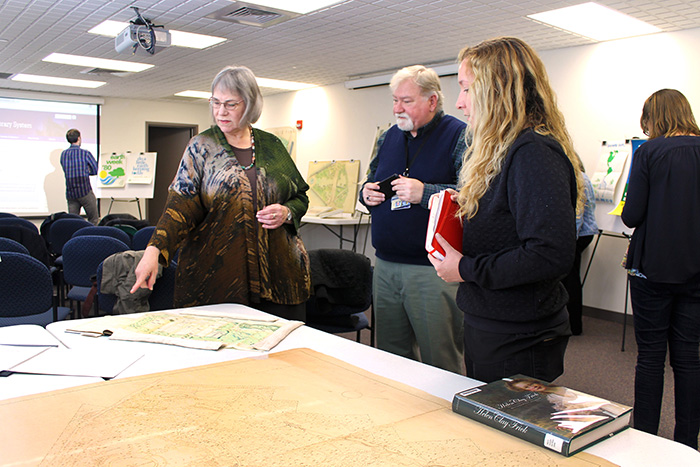
David R. Grinnell, Susan Rademacher and Kaitlyn Haynal
Hosts: Steve Tonsor, Director of Science and Research; Dan Pickering, Scientific Preparator and Abby West, from Vertebrate Paleontology; Albert Kollar, Geologist/Collection Manager from the Geology Department; Bob Davidson, Collection Manager and John Rawlins, Director, Center for Biodiversity & Ecosystems and Curator from Invertebrate Zoology; Alison Hale, Program Manager for Science and Research.
Behind-the-scenes access to the extraordinary collections at the Carnegie Museum of Natural History added valuable scientific perspectives to the activities of the workshop. In the Geology Department, Albert Kollar used the museum’s collection to underscore the shifting scientific status of the Anthropocene, and his interests in the scientific perspectives on the geological and atmospheric processes evident in paintings in the Carnegie Museum of Art collection. In the Department of Vertebrate Paleontology, Dan Pickering and Abby West showcased a selection of bones and fossils through which the processes of environmental change and extinction can be visualized. In the collections of Invertebrate Zoology, Bob Davidson and John Rawlins showed the workshop participants through the museum’s ‘bug rooms’, and used a selection of invertebrate specimens to discuss their sensitivity to climate change.
Workshop participants met with Eric Dorfman, Director of the Carnegie Museum of Natural History, to discuss the status of the Anthropocene as a major theme for the museum in the years ahead. Building on this theme, the group also engaged in a discussion with Edith Doron, the Senior Manager of Nexus Initiatives for Carnegie Museums of Pittsburgh, whose collaborative programming initiative Strange Times: Earth in the Age of the Human explored this theme in early 2017 through a range of public programs and events.
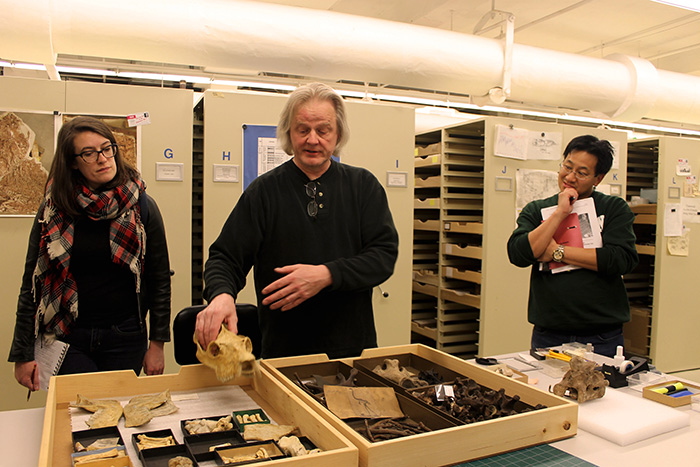
Colleen O’Reilly, Dan Pickering and Philip Kao in the 'Big bones room" at the Department of Vertebrate Paleontology
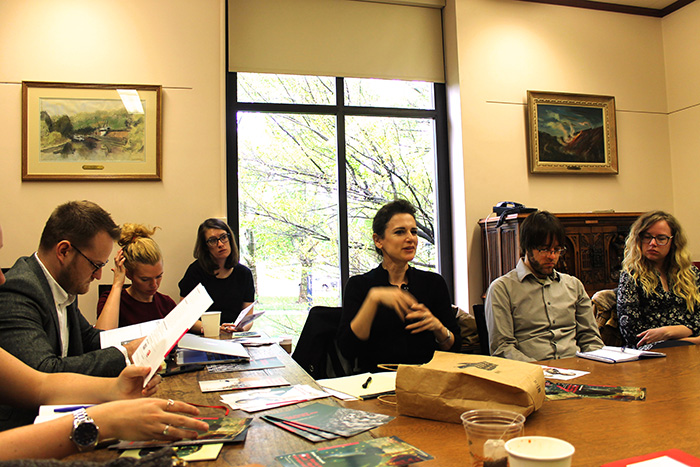
Edith Doron, Senior Program Manager of the Nexus initiative, meeting the workshop participants
Hosts: Louise Lippincott, Curator of Fine Art; Dan Leers, Curator of Photography; Rachel Delphia, Curator of Decorative Arts; Divya Rao Heffley, Senior Program Manager, Hillman Photography Initiative.
At the Carnegie Museum of Art, the workshop participants considered human interventions in the landscape through a series of works selected from collection storage. Several works exemplified the spectacle of the ‘natural’ disaster, from Johann Carl Richter’s Eruption of Vesuvius in 1771 (c.1779) to Rothengatter and Dillon’s photographs of the Johnstown flood in 1889. Group discussions focused especially on the work of Carnegie Museum of Natural History director Andrey Avinoff. The group also inspected one of his botanical illustrations at the Hunt Institute, but here we focused on the dense and complex symbolism of a group of watercolors depicting the cycles of nature. In the museum’s galleries, we explored a range of nineteenth century landscape paintings in which the presence of industry was visible, culminating in an extended exploration of the status of smoke in the murals of John White Alexander. In the decorative arts galleries, we considered materials of nature as they have been used (and abused) for furniture, glass and ceramics. Our visit concluded in the virtual environment of the Hall of Architecture where the group experienced Styles and Customs of the 2020s, a virtual reality installation exploring alternate visions for the near future of humanity.
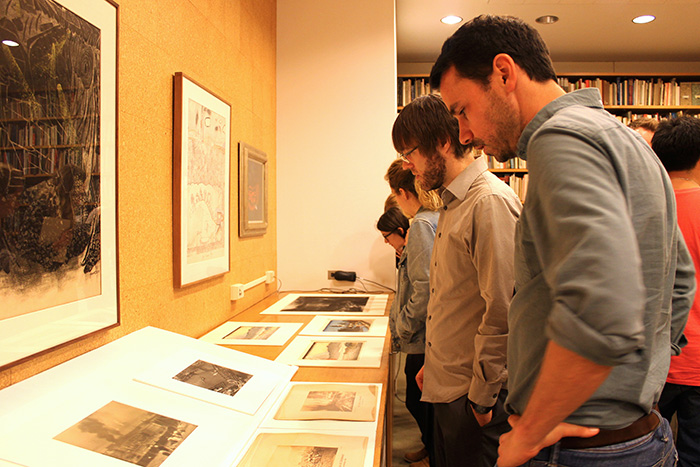
Photographs selected for the workshop by Dan Leers, Curator of Photography at the CMOA
Hosts: Robin Nicholson, Director; Sarah Hall, Chief Curator, Director of Collections; Amanda Gillen, Director of Learning & Visitor Experience; Greg Langel, Marketing & PR Manager; Jennifer Rogers, Social & New Media Manager.
After lunch at the Frick Café and a warm welcome by Amanda Gillen, the group was introduced to the interactive digital app currently being developed by Greg Langel and Jennifer Rogers, and which will provide a historical insight to the site and the buildings, as well as information on the species that populate the landscape of the site. Robin Nicholson gave an insightful overview of how the museum, once the home of the wealthy Frick family, opened up to the local community, not only through educational projects and events, but also tactical interventions into the landscape architecture of the site (opening the gate on Penn avenue, creating pathways on the site that connect the various buildings). Sarah Hall gave us a tour of the new exhibition of Elise Adibi’s Respiration paintings, part of the Frick’s collaboration with contemporary artists and the first example of an exhibition set inside the greenhouse. A feast not only for the eyes but also for the nose, soft floral scents emanate from these abstract paintings that are made with essential oils. An interesting particularity of this installation is its unusual location (a humid and wet greenhouse), surrounded by flowers and plants, which will affect the appearance of the paintings overtime, and which go against the usual museum norms of conservation.
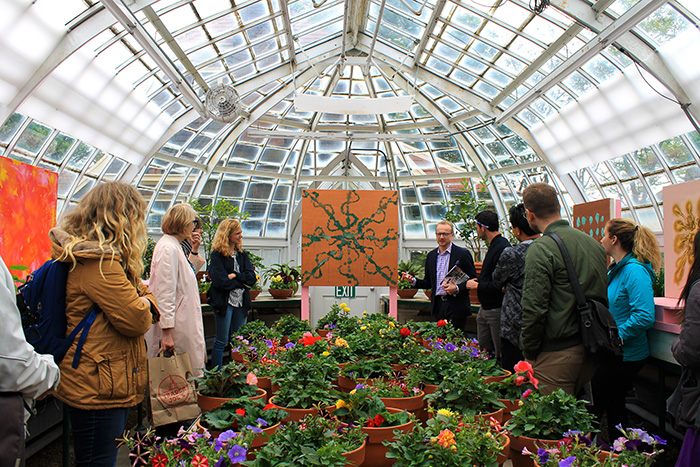
Robin Nicholson and Sarah Hall discuss about the Elise Adibi exhibition at the Frick Greenhouse
Hosts: John Paul Deley, Vice President and Director of the Detre Library & Archives; Matt Strauss, Chief Archivist; Sierra Green, Archivist and Leader of Archival Education Team.
At the Detre Library and Archives at the Heinz History Center, John Paul Deley and his team assembled a rich selection from the museum’s collections targeted to the research interests of workshop participants. The group inspected the a range of historic maps and plans of Pittsburgh and surrounds for their varied conventions of landscape representation, ranging from Allegheny, Monongahela, and Ohio River Survey Maps from the nineteenth century to Sanborn Fire Insurance maps documenting the expansion of Pittsburgh suburbia in the twentieth century. Other collections explored included the rich sources concerning Pittsburgh urban renewal contained in the Melvin Seidenberg Photographs collection, and sources concerning the industrialization of agriculture and food production in the H. J. Heinz Company Records.
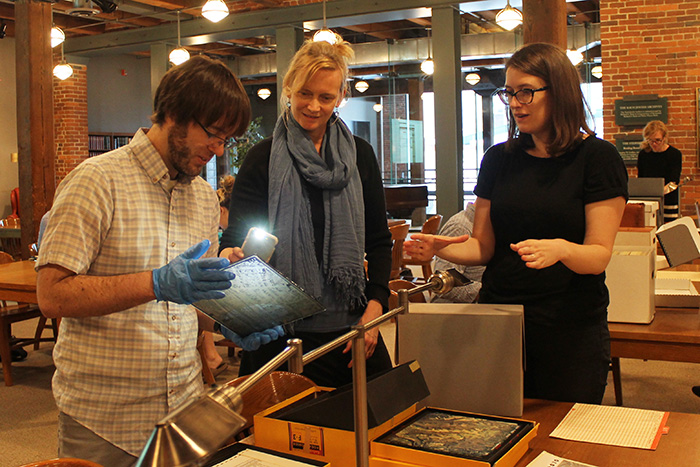
Workshop participants Zach Horton, Jennifer Waldron and Colleen O’Reilly with a glass plate negative – an aerial photograph – part of the Allegheny County Collection
Hosts: Charlotte (Chuck) Tancin, Librarian & Principal Research Scholar; Lugene Bruno, Curator of Art & Senior Research Scholar; Carrie Roy, Assistant Curator of Art.
From its rich collection of botanical books and prints assembled by Pittsburgh philanthropist Rachel Hunt, the Hunt Institute showcased diverse examples of how botany and gardens are documented through art, horticulture books, travel accounts and scientific illustrations, between the 17th and 19th centuries. The group looked at examples of masterfully colored renderings of plants by French and Dutch artists and engravers, destined for collectors in folio and quarto publications. Also we inspected several European exploration books that represented flowers from Asia and accounts on international shipping methods to transport seeds on lengthy boat travels. The highlight of this session was, probably for many, a fascinating book by Humphry Repton from 1816 on garden design, which included “pop-up” engraved representations of before and after landscape improvements. Plant nomenclature and scientific charts were explored with examples of 17th and 18th century books by Carl Linnaeus (1707-1778), who famously organised a classification system based on reproductive organs of plants, but also with Michel Adanson (1727-1806)’s Famille naturelle des plantes, a distinct system from the ones established by Buffon and Linnaeus.
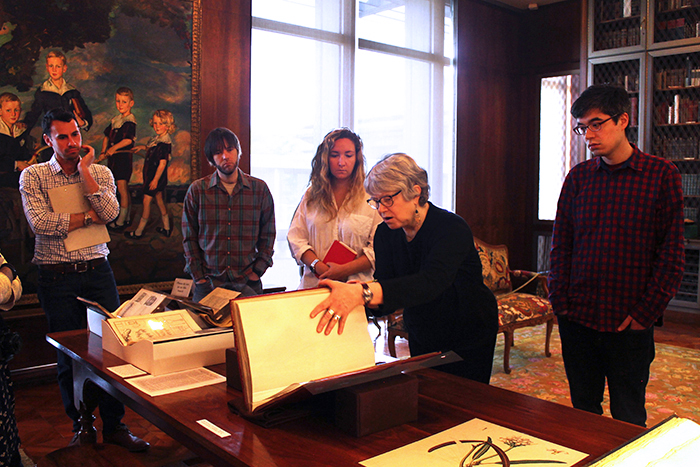
Ben Gordon, Zach Horton, Kaitlyn Haynal, Chuck Tancin, Librarian & Principal Research Scholar at the Hunt Library, and Evan Chen
Hosts: Chris McGinnis, Chief Curator, Rivers of Steel Arts; Ron Baraff, Director of Historic Resources and Facilities; Anna Johnson, Urban Ecologist and NSF Posdoctoral Fellow, Department of Biological Sciences, University of Pittsburgh.
The group visited Carrie Furnace on Wednesday morning, where Rivers of Steel care for the remaining two buildings (out of seven) from the Homestead Works, operated between 1907 and 1978. Designed today as a National Historic Landmark, the site testifies to the history of iron and steel production in the region, and its afterlife. With Anna Johnson we explored how the site was used during production, and discussed the collaborations with graffiti artists and and the local community who use the space in a creative approach for preserving the industrial heritage. Instead of forcing nature by planting vegetation and designing the landscapce, Rivers of Steel opted for a natural reclamation of the site: the resident biologist explained how local ecosystem regenerated on 70 years worth of toxic residue deposited on the land, without much of human intervention. The group then made its way to the Bost Building where the Rivers of Steel archives preserves the stories of those who participated to the industrial history of the city. The group was able to see some selections of 1950s postcards that testified to the promotion of Pittsburgh as the engine of the United States and the glorification of smoke as a symbol of wealth and industrial power. An exhibition on the upper floor displayed objects used by the steel workers and historical photographs of the mills.
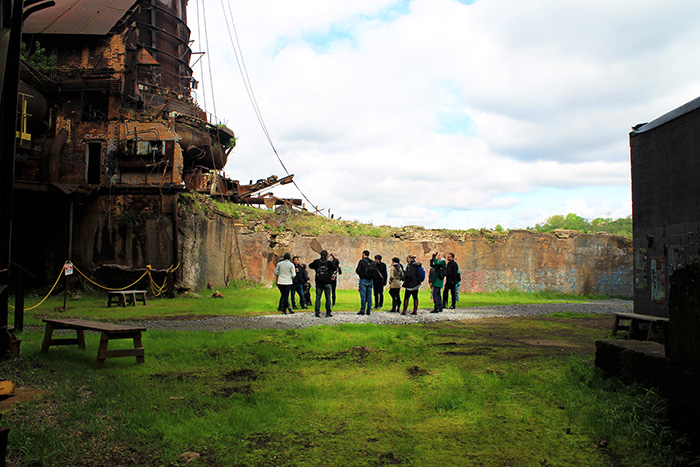
Workshop participants at the Carrie Furnace
Hosts: Jeanann Haas, Head, Preservation and Special Collections & Darlington; Jennifer Needham, Archivist, Special Collections; Kate Joranson, Head, Frick Fine Arts Library; Kiana Jones, Visiting Fine Arts Librarian; William Daw, Curator Curtis Theatre Collection; Kathy Haines, Associate Director, Center for American Music and other subject specialists; Clare Withers, Liaison Librarian; Leslie Poljak, Liaison Librarian; Mike Bolam, Metadata Librarian; Nora Mattern, Postdoctoral Researcher, Digital Scholarship Services.
The workshop participants met at Hillman Library’s Special Collections Reading Room, where material had been grouped into sections: a few prints from the famous Audubon’s Birds of America, of which Special Collections owns the complete folio set; cosmology treatises from the 1500s; magazines on environmentalism, feminism and spirituality from the 1960s; books on flora and fauna, one of which was the beautiful facsimile of Emily Dickinson’s Herbarium. Brought over from storage at the University Library Service were two 1948 comic books and a children’s book of the legendary Joe Magarac, local hero and “god of steel”, popularized by the US Steel company. During this session, the participants also had the chance to discover a few items from the collections of the Stephen Foster Memorial: early folk sheet music and song books that romanticized scenery and travels to the South. There were also examples of how organic materials are used for instruments and music, with a jawbone and with a gramophone record made out of shellac.
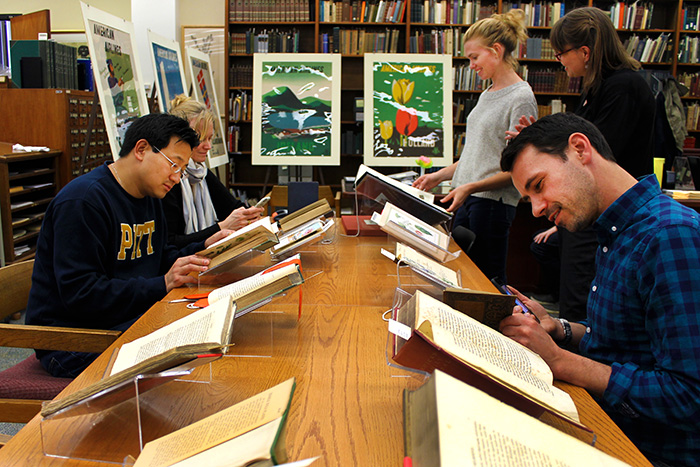
Workshop participants consulting books and prints at Special Collections, University Library System
Hosts: Isabelle Chartier, Curator from the University Art Gallery; Kate Joranson, Head, Frick Fine Arts Library; Kiana Jones, Visiting Fine Arts Librarian; Aaron Brenner, Coordinator, Digital Scholarship Services.
The group kicked off the week with an introduction to the collections of the University of Pittsburgh Art Gallery (UAG) and the Frick Fine Arts Library (FFAL). From the UAG, participants looked at prints, drawings and photographs representing various types of landscapes: Italian studies from the 17th and 18th centuries, industrial views of cities by English and American artists in the first half of the 20th century, picturesque prints after JMW Turner, sublime renderings of the American West, and sentimental depictions of farming at the turn of the 20th century. All of these works of art gave a sense of artistic conventions and constructions for landscape subjects. To corroborate this, illustrated books from the Library collection included instructions for such visual manipulations of nature, such as William Gilpin’s 1794 Remarks on Forest Scenery, or Hamerton’s Landscape from 1885. An old book with engravings by Giovanni Battista Falda from circa 1683 presented aerial views of Rome and landscape architecture of palatial gardens as a way to reinforce sovereignty and dominance of rulers. The circulation of such images of Rome later stimulated the Grand Tour, with artists and collectors seeking to experience the splendors of Italy. This early culture of nature tourism was echoed by the later book Picturesque America by William Cullen Bryant (1872-74), which includes essays and illustrations of pastoral landscapes, developing cities and natural treasures throughout the USA, as a way to construct a national self-image. The Frick Fine Arts Library also owns a large collection of artists’ books, and a selection presented to the group provided a closer look within our own contemporary culture of urban development (for instance, Ed Ruscha’s 1970 Real Estate Opportunities).
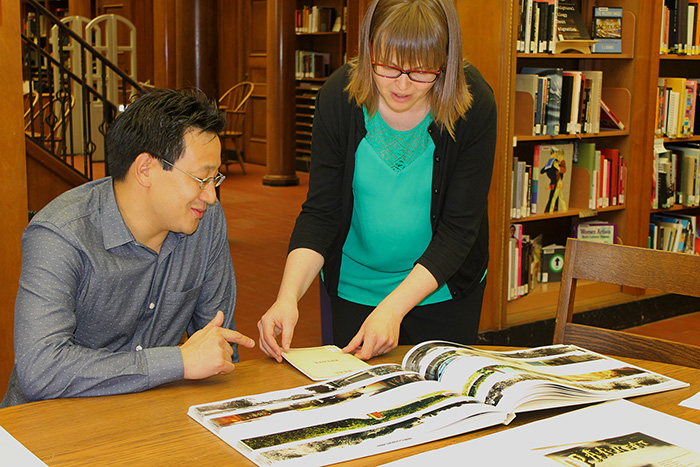
Philip Kao and Kate Joranson at the Frick Fine Arts Library
